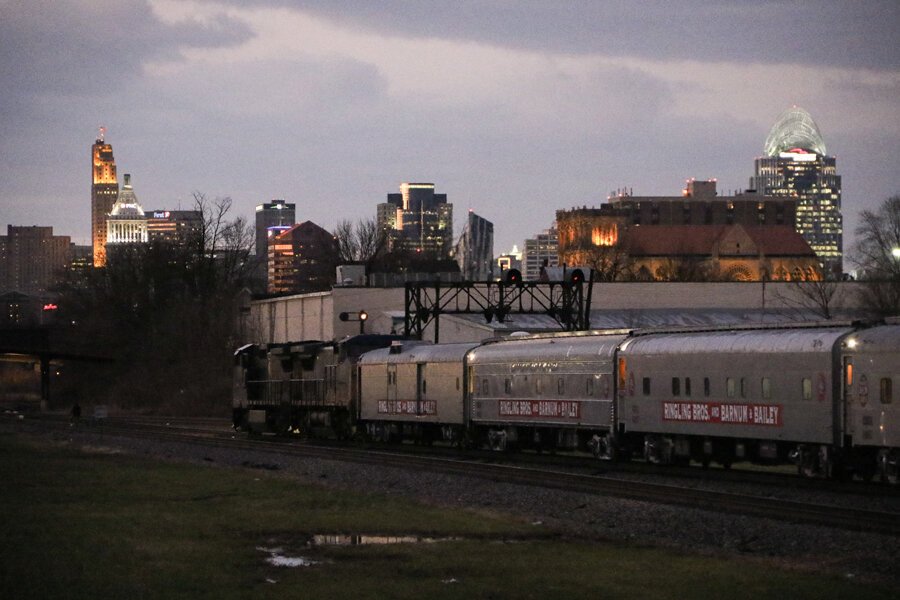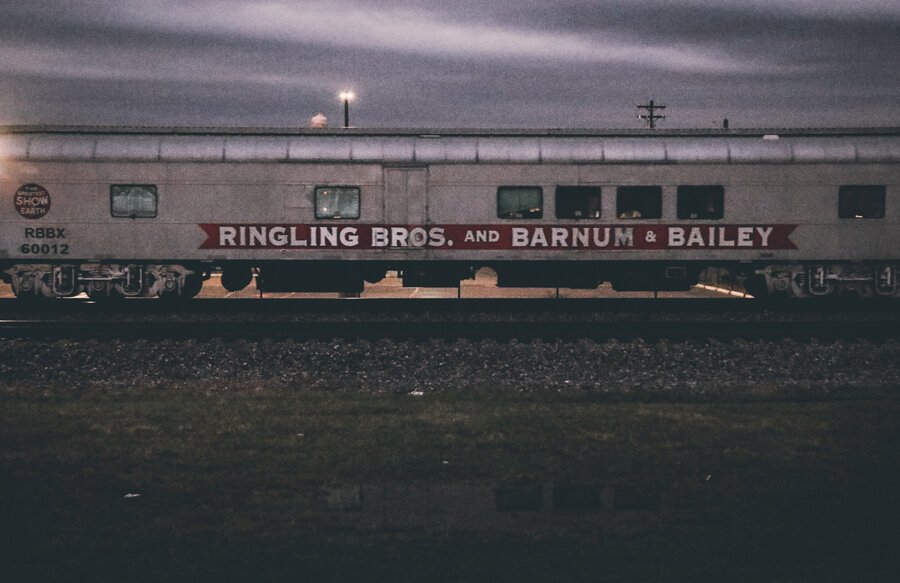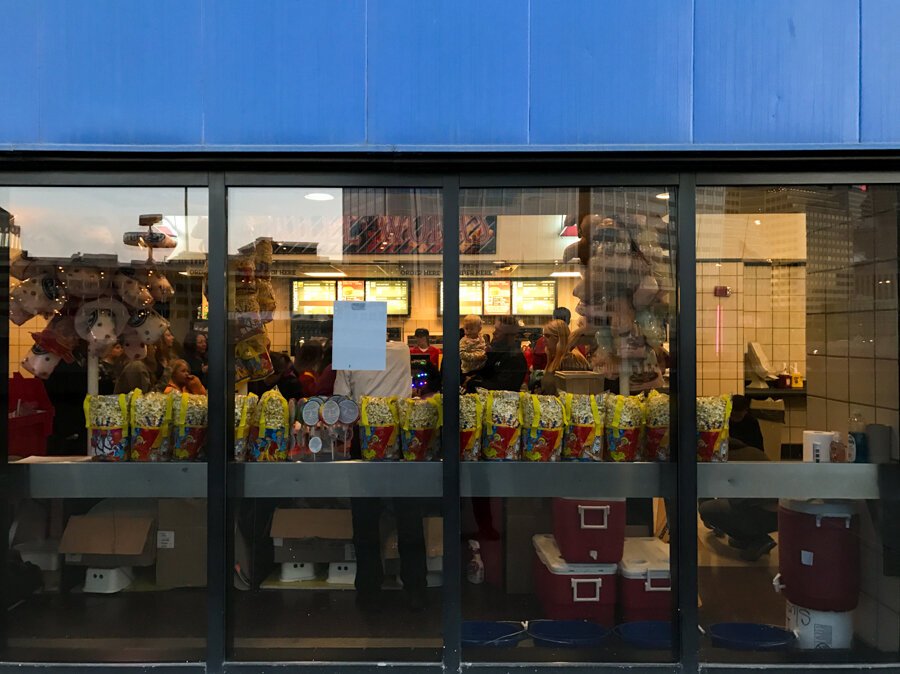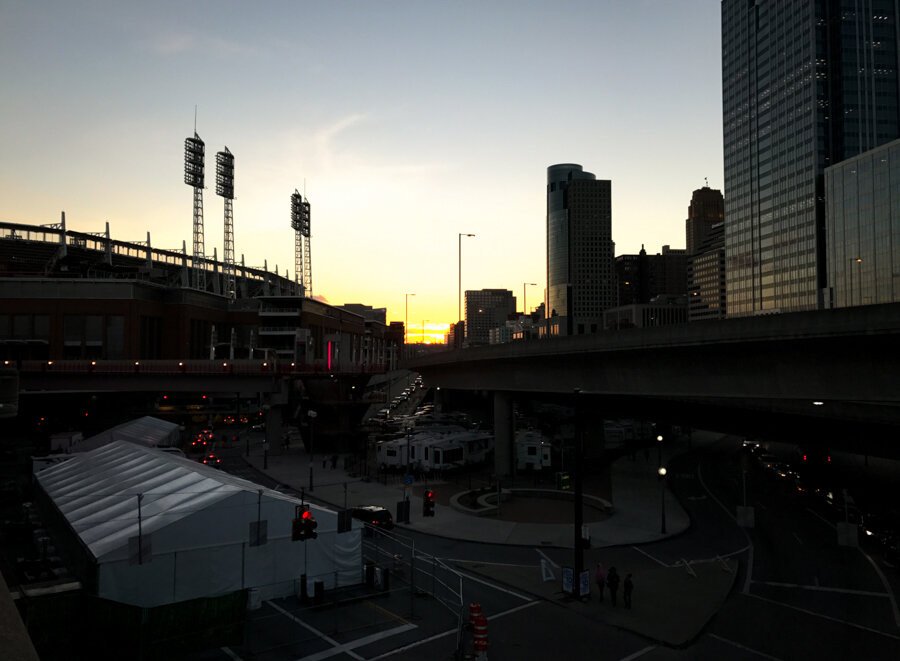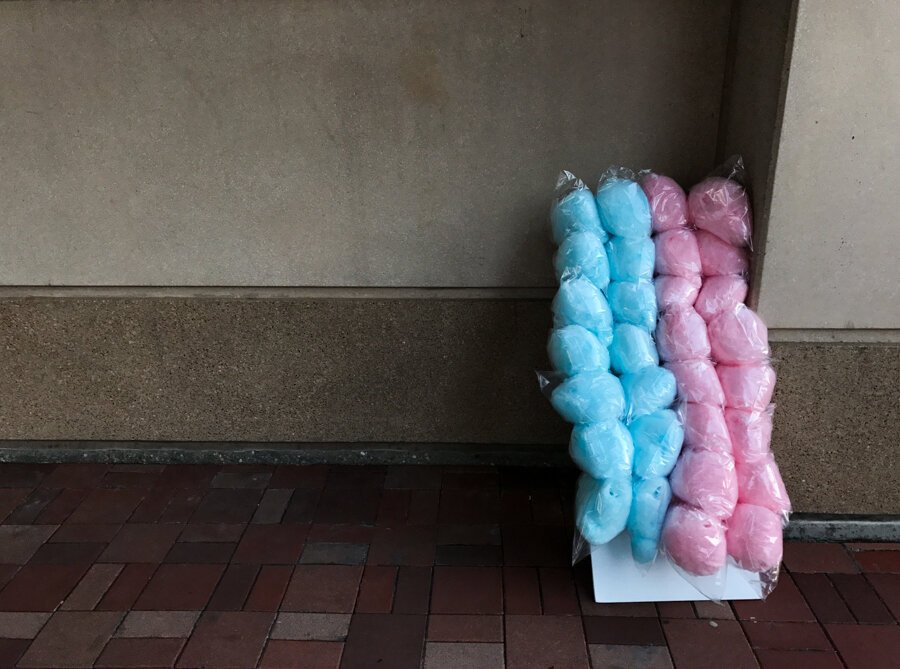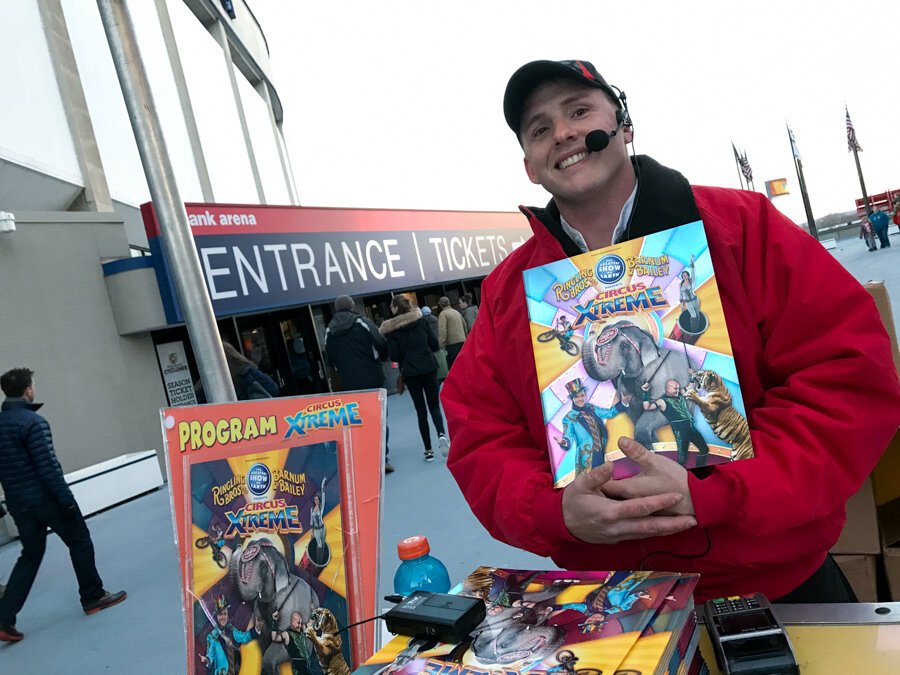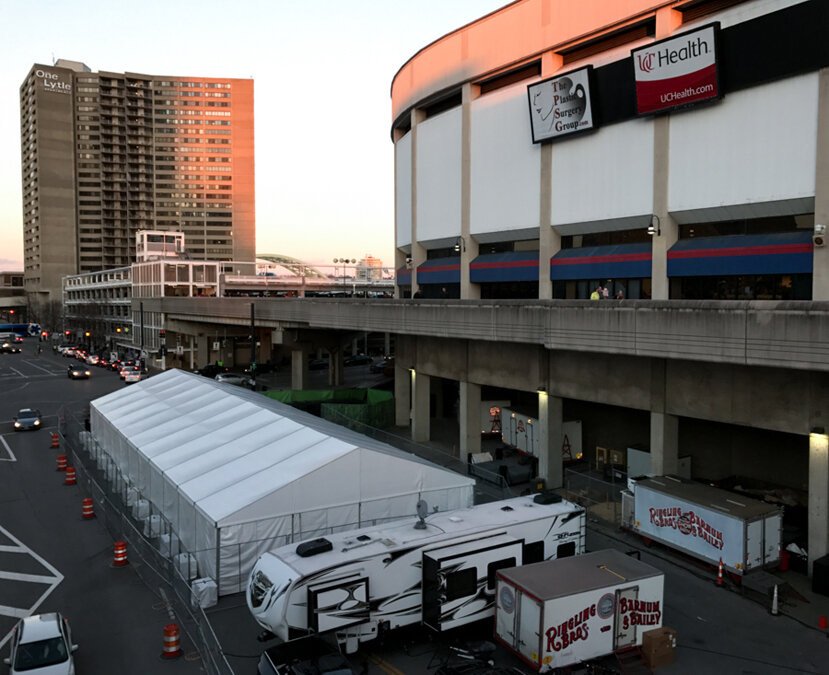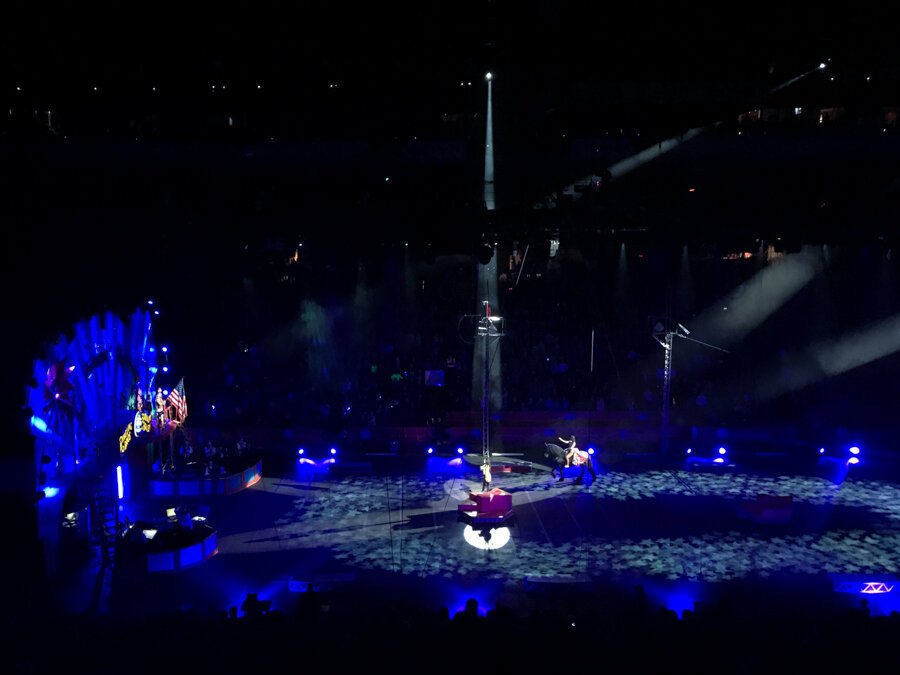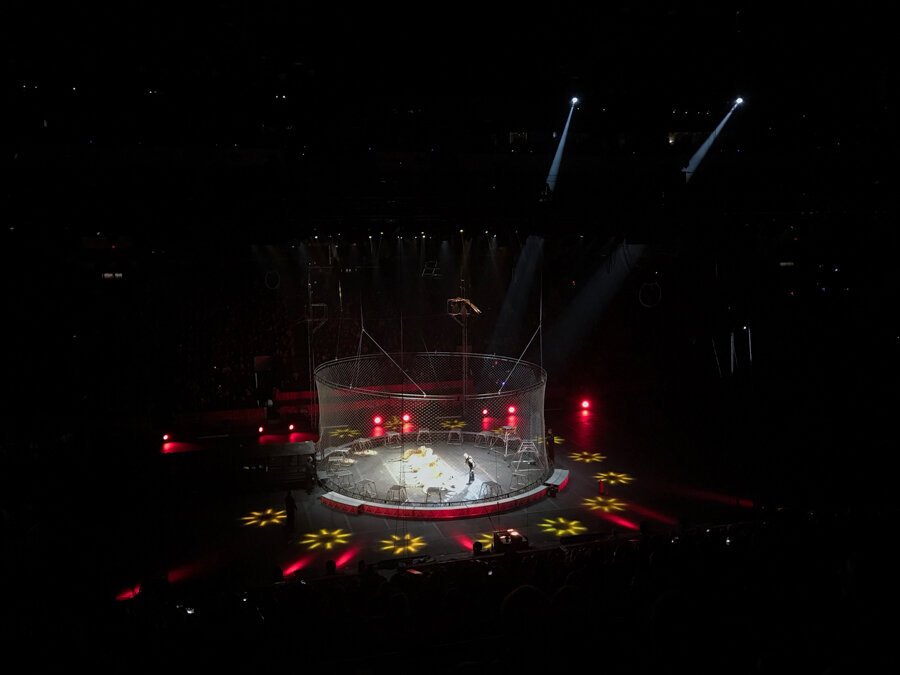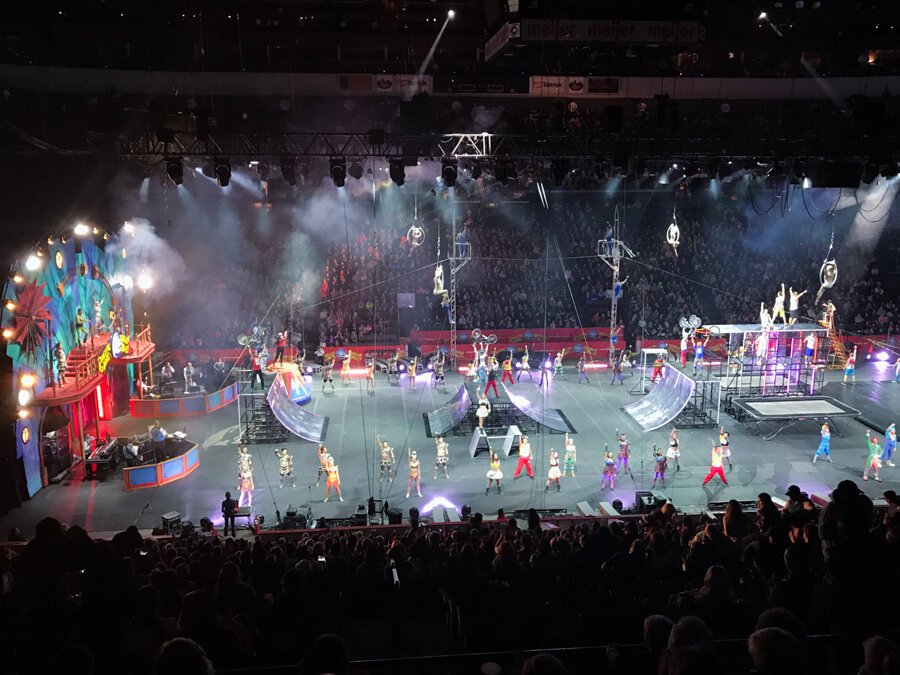The Circus Came and Went One Last Time
In January 2017 it was announced that the 146 year-old Ringling Bros. and Barnum and Bailey Circus would cease to exist. While a handful of dates were cancelled, Cincinnati would be one of the final touring stops. Evoking some childhood nostalgia, I went for what would not only be the first time in 15 years, but also one last time.
The Ringling Bros. "red unit" circus train makes its way into Cincinnati one last time.
My friend Paul was kind enough to take me with him to look for the circus train. Ringling Bros. operates two ~1 mi. long trains that bring their traveling shows and all of their equipment to alternating cities across the country each year. The “Red Unit” train was due in Cincinnati that morning, but it didn’t make it through until the last few glimmers of light were left in the evening sky. Paul and I snapped some grainy photos, pushing the cameras to higher levels of ISO and lower levels of quality. The train's passengers stood in the vestibules between cars, taking in their surroundings. They’d wave and shout an enthusiastic reply of “thank you” when we’d bellow “welcome to Cincinnati!” As the train slowed through Covington, Kentucky, and across the Clay Wade Bailey Bridge over the Ohio River, we caught up with it again, driving over the bridge’s automobile portion. Even more of the train’s passengers—circus employees, performers, and staff who call the rolling collection of cars home—were now outside, taking in the dynamic view of the Cincinnati skyline. They held children, snapped photos, waved and smiled. The circus train was entering the Queen City for the last time.
The traveling show known today as Ringling Bros. and Barnum and Bailey Circus, or “The Greatest Show on Earth,” traces its roots back to 1919 when P.T. Barnum’s circus merged with the Ringling brothers' circus. The combined circus operated under the traditional “big top” tents until 1956 when it transitioned to arena-based shows. The company has always utilized rail travel to transport its shows from town to town (along with a third truck-based show that operated from 2003-2015). Despite the lack of actual tents, Ringling Bros. is perhaps the best-known version of the modern day circus in our culture. When playing Cincinnati, the company typically sticks around for a week’s worth of performances. US Bank Arena (formerly the Firstar Center/The Crown/Riverfront Coliseum) is an annual stop, and the circus’ two traveling tours typically alternate which cities they visit before starting new shows. The train eventually makes its way to the riverfront tracks near the Montgomery Inn Boathouse, and then unloading begins via trucks down Pete Rose way to the nearby arena.
Despite the circus being an annual tradition for many, I hadn’t been to it since I was a kid. I had fond memories of it, though, and I remember always being really excited to go see it. There was once an old tape at our house that my sisters and I would wear out in the VCR when we wanted to watch clowns, elephants, and trapeze performers. It had probably been 15 years since I last went, and I figured I should go catch it one last time. My dad had the same idea, opting to treat the entire family like when all the kids were little.
Souvenir and snack vendors seen from outside of US Bank Arena.
In January 2017, the owners of Ringling Bros., Feld Entertainment, announced that the circus would close permanently following 146 years of operation. They cited high costs and declining attendance. By the time this show, “Circus Xtreme,” had pulled into Cincinnati in early March 2017, it had already been in Florida, the Carolinas, and Georgia. It’ll then head to Virginia, Pennsylvania, Massachusetts, New Hampshire, Connecticut, and end with a final show in Rhode Island, nixing the rest of the year’s Midwest and West Coast dates. The other touring show, “Out of this World,” will end shortly after in New York on Long Island, and both trains will head back to Florida to be decommissioned and auctioned off.
Trailers and staging areas for the circus lined up on Pete Rose Way.
We no longer need to gather up each kid into a minivan for a trip from the suburbs. Instead of taking in downtown from within the confines of a GMC Astro, I now see the city every day in varying levels of clarity when I walk into work from the bus stop or parking garage. I don’t view downtown (or most things) with the same wonder I did when I was a kid, but I do appreciate the city in different ways now. Nevertheless, it’s now a part of my every day existence and much different from the place I only got to see when there was a special event in town.
On the day the family was to go to the circus, I left work and decided to kill time at a nearby bar. I threw back a few beers while reading articles about the circus’ demise, and I listened to the two men atop the stools next to me complain about their ex-wives. I ate chicken fingers and french fries while they discussed Lenten fish sandwiches and argued about who had the worst impending weekend lined up with their children’s activities, all while they fruitlessly attempted to flirt with the much younger bartender. When I was a kid attending the circus, I had no idea that my life would turn out the way it has (I assumed I’d be a fighter pilot ala Top Gun or race car driver ala Jeff Gordon rather than a professional photographer/writer). As an adult waiting to attend the circus one last time, I at least had one example of how I didn’t want the rest of it to turn out.
The articles I read summed up the immense costs and logistics of running a circus, the changing tastes of the American public, and all the challenges those situations created. The comment section and Twitter ignored these statements, claiming the circus was still immensely popular; apparently, it is actually being forced to shut down by a cabal of coastal elites and liberal tree huggers who hate this country.
I hopped on the next streetcar to the riverfront and contemplated the effects of indulging in nostalgia. The closure of Ringling Bros. signals the end of an era in American popular culture, and that was my main motivation for going—to watch the closure of a chapter in history. I got off the streetcar—something that didn’t exist the last time I went to see the circus—and I stood at the riverfront between two new stadiums, new parks, new buildings, and new towers. As much as the city and I have changed, the circus has always remained a regular visitor. All the new development by the rail stop visually obscures the nearby arena. Fittingly, aside from a few cosmetic upgrades over the years, US Bank Arena still oozes the same feel of when I’d visit the circus as a kid (and from other people’s comments, the same feel as when they’d visit in the '70s and '80s). Heading towards what was once known as the Riverfront Coliseum, I passed a street vendor hawking cheap, plastic light up toys for far cheaper than they were available inside.
Knock-off souvenirs for sale outside of the arena.
Cotton candy (also cheaper outside rather than inside) was lined up against a nearby wall as he tried to tempt passersby. I walked past families with small kids who were excitedly talking about what they were about to see. Police officers whistled for traffic to ebb and flow nearby, while those holding “anything helps” signs stood stoic.
Once I reached the arena plaza, the memories started flooding back. A circus vendor posed for a quick photo while selling souvenir programs.
The circus’ equipment was lined up on the streets below beneath the Carter Administration-era venue. The only tents the circus traveled with in its last days were not ones of the big top variety; rather, they were tents used to temporarily store equipment and house camels.
I met up with my family, everyone coming from their respective jobs and careers rather than having rolled down together in a minivan. We went in, took our seats, and noticed the lack of three rings. Since the circus retired its elephants a few years back, the physical stage area seemed smaller in size. The national anthem was played by a live band while a horse emblazoned with the star spangled banner marched about.
The circus’ first female and last overall ringmaster narrated the show. There were tigers, acrobats, feats of strength, a performer launched from a cannon, and an intermission.
In the concourse, the souvenir stands still sold plush elephants. The circus retired the animals to a conservation center the previous year following mounting pressure and criticism from the public. The souvenir stands also sold light up swords of a significantly higher quality than those of the independent vendors outside.
I must've been 7 or 8 when my parents took my friend Brian and me to see the circus for my birthday. We were excited for the show, but even more so to get toy swords. It’s all we talked about at school that week. We ended up coming home with two light up weapons; the handles were shaped like dragons, and the plastic fire they breathed made up the blade. They’d strobe with light when you clicked the button upwards. Twenty years later, I wish I still had that sword, but I didn’t remember it until I went to the circus again as an adult and saw a young kid toting one around the arena concourse. The colors had changed, but the circus still sold the same model. As I made my way back to my seat, I instantly felt nostalgic, but there was a hint of sadness because I hadn’t kept that souvenir from years ago.
The second half of the show featured the more “extreme” acts: BMX bike riders with slack line and trampoline performers. As the city and world outside the arena had evolved, the circus had to as well; the non-traditional circus acts were a direct response to changing tastes and culture. Nevertheless, it was all quite impressive, even if the days of sideshow performers and captive animals are now gone.
I left the circus grateful that I had experienced a closing chapter in American history. Nostalgia can often be a painful thing to indulge in. I didn’t want to spend the show bemoaning getting older or stereotypically lamenting the challenges of being an adult compared to the naivety of being a child. I enjoyed the memories that the circus brought back, but I didn’t want to get caught up in them. For a few hours, the circus was a nice distraction from nostalgia and life—one I won’t be able to use again, and one I only used since it was the last chance to see it. Having written about history here for the past ten years, it’s often easy to romanticize and see things you remember or study as being better than the life currently around you. The circus didn’t do that for me; it simply kept me smiling for a little while. I left the arena no better or worse than I was before. I was just glad that I got to see it one last time. As I went on navigating the rest of my life, the circus train pulled out of Cincinnati on a rainy morning, heading to the end of its own.
Update | March 24, 2023:
In 2023, the Ringling circus returned in a new iteration that no longer features animal acts.

